
* From the 1950s into the 1970s, there was extensive experimentation with "vertical take-off / landing (VTOL)" aircraft around the world, with a number of different approaches to the technology explored. One of the approaches was the "flat-riser", in which a jet-powered aircraft lifted off in a horizontal attitude. The USA flew three flat-risers jets, including the "Bell X-14", the "Lockheed XV-4", and the "Ryan XV-5", with mixed results; a flat-riser fighter, the "Rockwell XFV-12", was designed as well, but was abandoned before serious testing began. This document provides a history and description of the US VTOL flat-risers. A list of illustration credits is included at the end.
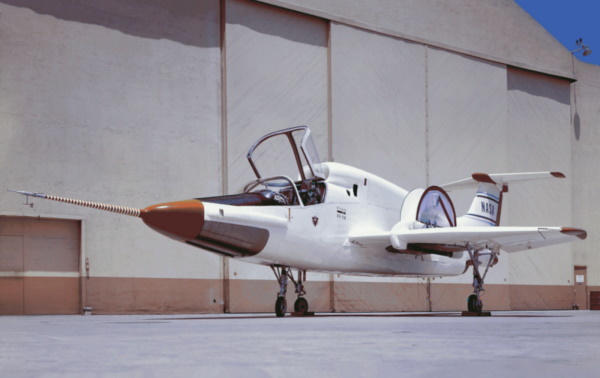
* In 1955, the Bell Aircraft Company was awarded a US Air Force (USAF) contract to build a low-cost "vertical take-off & landing (VTOL)" flight demonstrator. The result, the "Bell Model 68" AKA "X-14", performed its initial flight on 19 February 1957, with test pilot David Howe at the controls.
The X-14 was clearly an experimental machine. It was made of aircraft aluminum, with straight low wings, an open cockpit with side-by-side seating -- it did not have ejection seats -- and fixed tricycle landing gear. It was powered by twin British Armstrong Siddeley Viper ASV8 turbojet engines with 7.8 kN (795 kgp / 1,750 lbf) thrust each, mounted at the center of gravity, featuring moveable thrust deflector vanes. There were reaction jets at the wingtips and tail, fed by engine bleed air, for control in vertical flight. It had an external tank under each wing near the root; it is not clear if it had any internal tanks.
The X-14 was cobbled together from parts from two aircraft: wings and landing gear of a Beech Bonanza light civil aircraft, and the rear fuselage, including the tail assembly, from a Beech T-34 Mentor trainer. The initial flight was purely vertical, with the first transition to horizontal flight and back on 24 May 1958. The landing gear legs proved to be too close to the ground, which revealed a peculiar "suckdown" effect: the backblast from the ground actually pulled the machine down. Lengthening the legs eliminated the problem.
The Viper turbojets didn't generate enough thrust to allow the machine to carry enough test gear, and so in 1959 they were replaced by General Electric J85-GE-5 turbojets with 11.9 kN (1,215 kgp / 2,680 lbf) thrust each. This machine was handed over to the US National Aeronautics & Space Administration's (NASA) Ames Research Center in California as the "X-14A", which made extensive use of it for VTOL research.
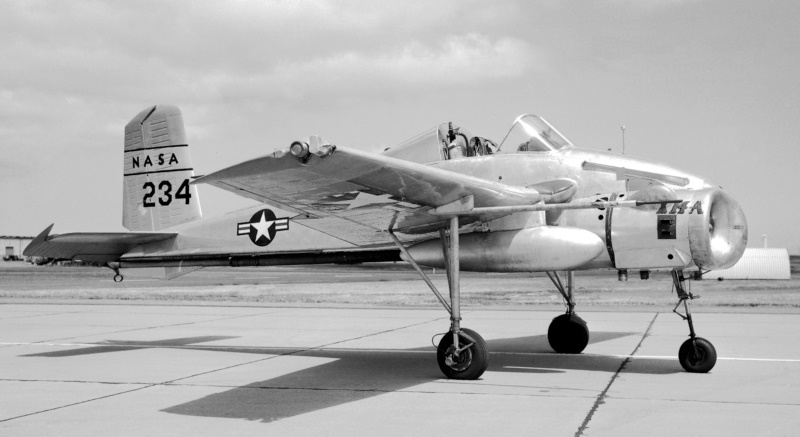
NASA astronauts also flew it as a trainer for landing on the Moon, though NASA acquired a specialized vehicle -- the "Lunar Landing Research Vehicle (LLRV) specifically for that purpose. In 1971, the X-14A was refitted with uprated J85-GE-19 engines, to be also fitted with an onboard computer and a digital fly-by-wire system, hooked up to auxiliary control thrusters, that allowed it to emulate the flight of other VTOL aircraft. The updated aircraft was designated the "X-14B".
___________________________________________________________________
BELL X-14B:
___________________________________________________________________
wingspan:
16.7 meters (54 feet 9 inches)
wing area:
34.9 sq_meters (375 sq_feet)
length:
7.92 meters (26 feet)
height:
4.93 meters (16 feet 2 inches)
empty weight:
1,440 kilograms (3,175 pounds)
max operating weight:
1,395 kilograms (4,270 pounds)
max speed:
275 KPH (170 MPH / 150 KT)
service ceiling:
5,500 meters (18,000 feet)
range:
480 kilometers (300 MI / 260 NMI)
___________________________________________________________________
The X-14B was damaged beyond repair in a landing accident on 29 May 1981, and that was the end of the program. This was the only major accident involving the X-14; it had been flown by dozens of pilots, with no real troubles. Lacking ejection seats, it had either been flown very low, or high enough to allow the pilot to bail out successfully. There was consideration of an "X-14C" with an enclosed cockpit, and an "X-14T" trainer, but neither happened. At last notice, the X-14B was in private hands, being refurbished as a museum exhibit.
BACK_TO_TOP* In 1949, the brilliant Hungarian-American aviation engineer Theodore von Karman published a paper on his "augmented jet ejector" concept -- in which thrust from a jet engine was augmented by passing through a carefully-configured exit chamber that drew in additional air through intake tubes. The chamber could be extended to multiple stages, with lab tests showing a three-stage system could multiply thrust by 2.3.
The Lockheed Company was very interested in von Karman's jet augmentor. In 1959, Lockheed engineers came up a design for an experimental demonstrator based on the technology, and also built a flying VTOL test rig, powered by twin Fairchild J44 turbojets with 4.48 kN (450 kgp / 1,000 lbf) thrust each. The rig was later updated to Continental J69 turbojets. The rig didn't look much like a flying machine, being a box with twin engines, and only "flew" to the extent of getting off the ground.
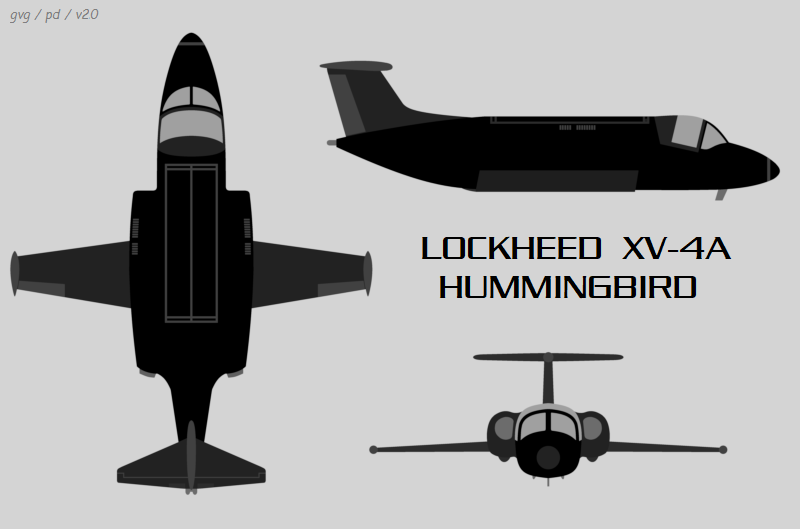
Lockheed had gambled that the US Army would be interested in their VTOL design -- and in 1959, on being presented with the design, the Army awarded Lockheed a contract for two experimental demonstrator aircraft, originally being designated "VZ-10", but redesignated "XV-4A" in 1962. The first prototype performed its initial flight, a conventional take-off, on 7 July 1962, with flight tests performed at Dobbins Air Force Base in Georgia. The first free hover flight was on 24 May 1963, with the first transition from hover to forward flight on 8 November 1963.
___________________________________________________________________
LOCKHEED XV-4A:
___________________________________________________________________
wingspan:
7.82 meters (25 feet 8 inches)
wing area:
9.66 sq_meters (104 sq_feet)
length:
9.96 meters (32 feet 8 inches)
height:
3.58 meters (11 feet 9 inches)
empty weight:
2,265 kilograms (4,995 pounds)
max operating weight:
3,266 kilograms (7,200 pounds)
max speed:
630 KPH (520 MPH / 450 KT)
service ceiling:
12,200 meters (40,000 feet)
range:
695 kilometers (600 MI / 520 NMI)
___________________________________________________________________
The XV-4A had mid-mounted tapered wings, a tee tail, a side-by-side cockpit with a canopy that hinged open to the right, and retractable tricycle landing gear.
It was powered by twin Pratt & Whitney JT12A-3LH turbojet engines with 15 kN (1,496 kgp / 3,300 lbf) take-off thrust each, in nacelles alongside the fuselage. The engines drove a thrust diverter system, fed through doors on top and exhausting through doors on the bottom. The diverter system was interleaved, so that the failure of one engine wouldn't unbalance the aircraft. The engines could be switched to conventional exhaust for forward flight; they also drove thrusters at nose, tail, and both wingtips. For hovering flight, the Hummingbird was fitted with an auto-stabilization system, derived from one developed for contemporary helicopters.
The XV-4A did not meet performance specs; the ducting system was excessively complicated and heavy, leading to thrust losses, and the augmentation didn't work as well as hoped. The machine crashed on 10 June 1964, the pilot being killed and the aircraft a loss. Although progress had been made in the program, the US Army was focused on the war in Southeast Asia, and so gave up on the XV-4A.
The Hummingbird program remained in suspension for a year, until the USAF awarded a contract to Lockheed to modify the second, unflown, prototype aircraft between 1966 and 1968 to "XV-4B" standard. The two Pratt & Whitney JT12 engines were replaced with six General Electric J85-GE-19 turbojets with 13.41 kN (1,365 kgp / 3,015 lbf) thrust each. Four of these engines were mounted vertically, in a 2 x 2 arrangement, to act as lift jets -- the impractical ducting scheme having been abandoned -- while J85 was mounted horizontally in a nacelle on each side of the fuselage. The "XV-4B", as it was redesignated, was also fitted with an autostabilization / automatic flight control system.
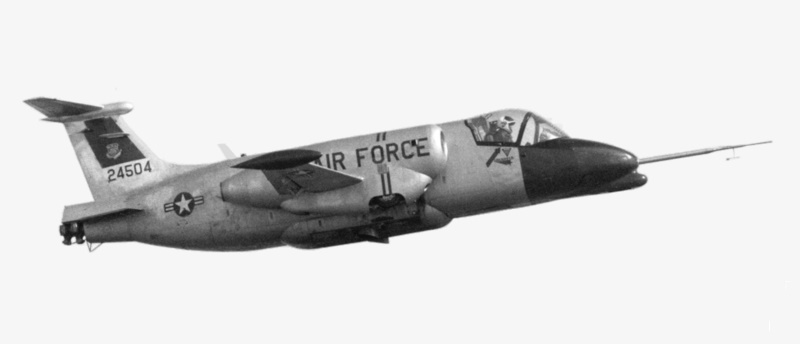
The XV-4B was rolled out on 4 June 1968. It had a slightly increased wingspan and height, plus increased weight. Lockheed ran tests on the aircraft for a few months, then passed it on to the USAF, with North American Rockwell conducting test flights at Edwards Air Force Base in California, on behalf of the USAF. This aircraft was also lost in a crash, on 14 March 1969, but pilot Harlan J. Quamme escaped uninjured, using the ejection seat. There was apparently consideration of building another XV-4B, but the decision was made that there was no sense in pursuing the program further.
BACK_TO_TOP* Under a US Air Force contract, the Ryan company had flown a VTOL aircraft -- the "X-13 Vertijet", a "tailsitter" or "flying pogo" that took off and landed on its tail -- from 1955 to 1957. It was an amusing idea, but impractical for operational use with the technology available. In parallel, Ryan engineers had been tinkering with an alternate VTOL scheme, an exhaust-driven "liftfan." In 1959, the US Army awarded a contract to Ryan for two Ryan "Vertifan" demonstrators using liftfans, originally designated "VZ-11", changed to "VZ-5A" in 1962. NASA performed wind-tunnel tests with models for the development program. The first demonstrator performed its initial flight on 25 May 1964.
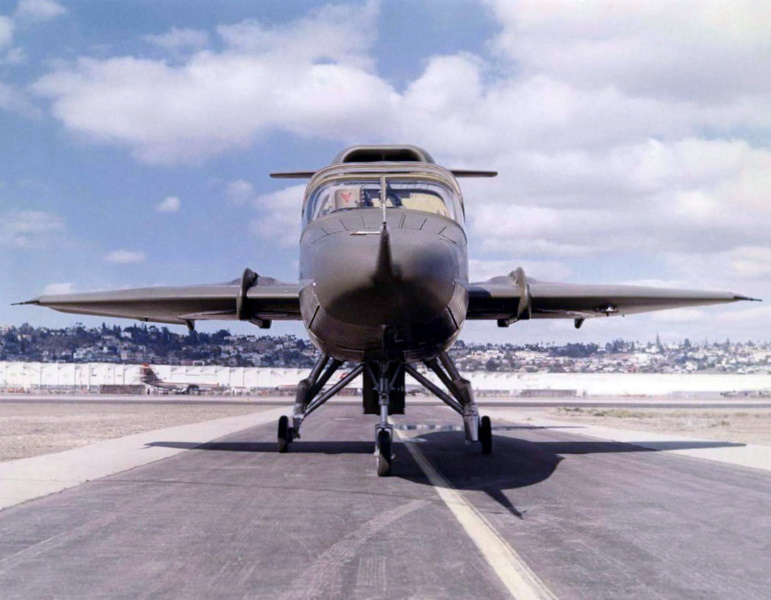
The XV-5A had retractable tricycle landing gear, a side-by-side cockpit, a low-mounted cranked-delta wing, and a tee tail. All landing gear had single wheels, the main gear retracting backward into the rear fuselage -- it had an overly narrow track -- the nose gear retracting forward. The main gear had two extended positions, towards forwards and towards back, for VTOL or conventional take-offs respectively. The aircrew sat on ejection seats, under a rear-hinged canopy.
The XV-5A was powered by twin J85-GE-5 turbojets with 11.8 kN (1,205 kgp / 2,658 lbf) thrust each -- the intakes being mounted on top of the fuselage, behind the cockpit. The machine had a GE X353 lift fan in each wing for vertical take-off, and an X376 lift fan in the nose for pitch control. The wing fans had a diameter of 159 centimeters (62.5 inches) each, and the nose fan had a diameter of 91 centimeters (36 inches). The fans were driven by engine exhaust, with a crossover ducting arrangement to ensure one engine could drive both wing fans. There were two paddles or "spoilers" in the engine exhaust to divert thrust to the sides, eliminating forward thrust while in hover.
The fans provided a vertical lift of about 71.2 kN (7,255 kgp / 16,000 lbf), six times the thrust of the two engines. The wing fans were covered by doors when not in use, the nose fan by a set of louvers. There were louvered vanes underneath the wing fans to provide forward and backwards thrust; and pivoting ducts under each side of the nose that could direct thrust up or down. In hover, the nose fan controlled yaw, differential adjustment of the wing fans provide roll control, while the underwing louvers controlled pitch. In forward flight, conventional control surfaces were used.
___________________________________________________________________
RYAN XV-5A VERTIFAN:
___________________________________________________________________
wingspan:
9.09 meters (29 feet 10 inches)
wing area:
24.18 sq_meters (260 sq_feet)
length:
13.56 meters (44 feet 6 inches)
height:
4.5 meters (14 feet 9 inches)
empty weight:
3,420 kilograms (7,541 pounds)
max operating weight (for vertical take-off, +10% for level take-off):
5,580 kilograms (12,300 pounds)
max speed:
880 KPH (545 MPH / 475 KT)
service ceiling:
12,200 meters (40,000 feet)
range:
1,600 kilometers (1,000 / 870 NMI)
___________________________________________________________________
The XV-5A was finished in stereotypical Army green. Since the machine was so different from a conventional aircraft, Ryan built a flight simulator to familiarize pilots with its operation, before they actually attempted to perform a flight. Trials proved difficult: the lift fans didn't provide enough thrust, and transitions between horizontal and vertical flight had controllability problems. Landings were also tricky, one problem being the wing fan doors, which didn't always work as intended.
One of the two XV-5As was destroyed in a crash during a public flight demonstration on 27 April 1965, Ryan test pilot Lou Everett being killed, his ejection seat not working as required. The accident investigation suggested pilot error as the cause of the accident, due to confusions over the controls. The controls were rearranged in the surviving machine. Unfortunately, it suffered a very hard landing on 5 October 1966; the pilot, Major David H. Tittle, was also killed after ejecting.
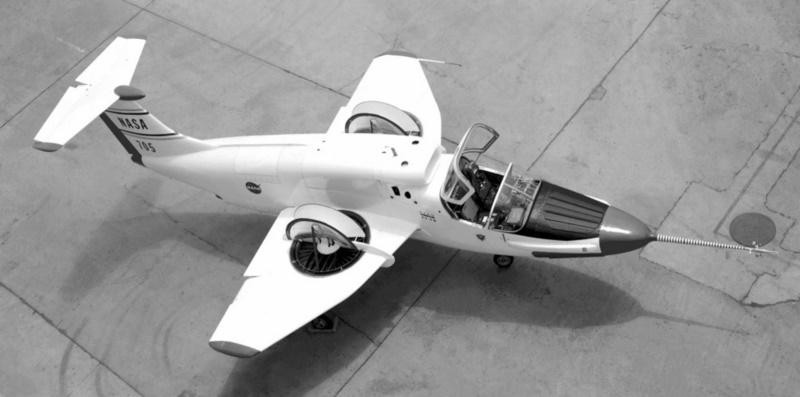
The machine was still repaired and put into service as the "X-5B", featuring a wider-track fixed undercarriage, improved controls, and uprated lift / propulsion systems. It was passed on to NASA and painted in spiffy white & blue NASA colors. It remained in trials to 1971, proving very satisfactory to NASA. It now resides at the US Army Aviation Museum, Fort Rucker, Alabama.
The two fatal accidents cast a shadow over the program, but the lift-fan concept was seen as promising -- the only difficulty being the added weight and complexity of the fan system. Ryan considered a number of concepts for "fan-in-wing" aircraft, including high-speed fighters, cargolift aircraft, and airliners. They didn't happen, but a single large, shaft-driven lift fan, mounted behind the cockpit, is fitted to the F-35B VTOL variant of the Lockheed Martin F-35 Joint Strike Fighter.
BACK_TO_TOP* As a footnote to the story of US VTOL flat-risers, in the 1970s Rockwell attempted to develop a VTOL fighter for the US Navy, the "XFV-12A". The Navy issued a request for proposals for a VTOL fighter in 1972; the goal was for the machine to have Mach 2 speed and AIM-7 Sparrow armament, for operation off a small "Sea Control Ship" that was under study at the time. Rockwell won the award and proceeded to develop a prototype.
To cut costs, the prototype featured parts from other aircraft, including the nose from a Douglas A-4 Skyhawk and intakes from the McDonnell-Douglas F-4 Phantom. The XFV-12A was of canard configuration -- in fact, the canards were so large, half the area of the wings, that it could be thought of as a tandem-wing aircraft. It had twin tailfins, one on the end of each wing, and a small plate at the end of each canard.
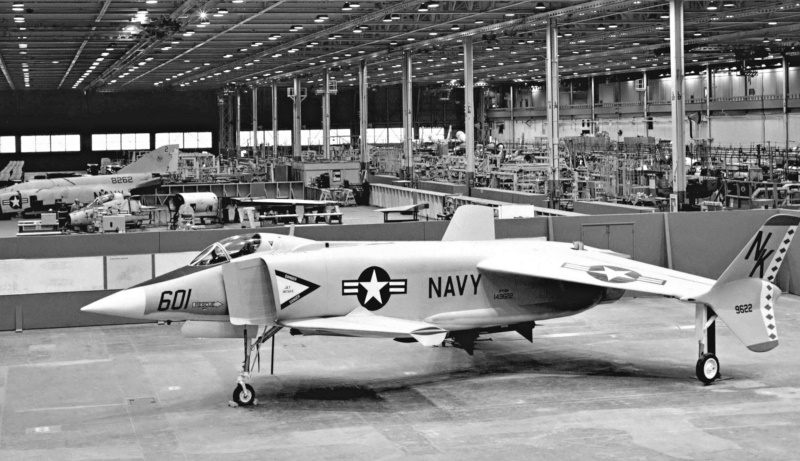
It was powered by a Pratt & Whitney F401-PW-400 afterburning low-bypass turbofan engine, with 130 kN (13,605 kgp / 30,000 lbf) thrust in afterburner. For vertical take-off, thrust was redirected through ducting to the wings and canards. These flight surfaces had full-span flaps at the rear, with an equal-length louver surface ahead of them -- both being pitched to upright position to divert the airflow downward; the canards also had front-edge flaps that tilted down. The scheme was referred as the "thrust-augmented wing".
Armament was to be a 20-millimeter M61 Vulcan 6-barreled Gatling cannon and four air-to-air missiles, all missiles carried under the fuselage -- either two AIM-9 Sidewinder and two AIM-7 Sparrow air-to-air missiles, or four AIM-7s. They had to be carried under the fuselage, since they couldn't be carried under the wings.
___________________________________________________________________
ROCKWELL XFV-12A:
___________________________________________________________________
wingspan:
8.69 meters (28 feet 6 inches)
wing area:
27.2 sq_meters (293 sq_feet)
length:
13.39 meters (43 feet 11 inches)
height:
3.15 meters (10 feet 4 inches)
empty weight:
6,260 kilograms (13,800 pounds)
operating weight:
8,845 kilograms (19,500 pounds)
max speed:
Mach 2
___________________________________________________________________
Ground testing began in the summer of 1977. The tests showed the machine couldn't get off the ground in vertical flight, which had been hinted at in preflight tests. The problem was mostly the ducting, which drained off most of the exhaust power. The Navy decided not to try to fix the problems -- that was an unpromising prospect, while the service had given up on the Sea Control Ship concept -- and abandoned the program.
A planned second prototype was never completed. A model survives of an operational "FV-12A" -- with stub wings behind the canards for carrying bombs and such, plus two Sidewinders most unconventionally carried on the outside of each tailfin. It was an interesting aircraft; too bad it didn't work out. Then again, the fact that it never got off the ground means it might have saved the lives of some test pilots.
BACK_TO_TOP* Sources include:
I had to scavenge details from online sources, such as Wikipedia. These aircraft are not over-documented.
* Illustrations credits:
* Revision history:
v1.0.0 / 01 sep 20 v1.0.1 / 01 jul 22 / Review & polish. v1.0.2 / 01 jun 24 / Review & polish. (+)BACK_TO_TOP
